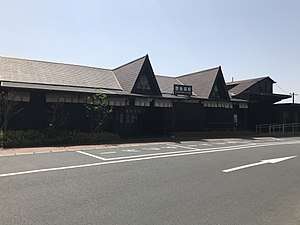Bungo-Mori Station
Bungo-Mori Station (豊後森駅, Bungo-Mori-eki) is a railway station on the Kyūdai Main Line operated by JR Kyushu in Kusu, Ōita Prefecture, Japan.[1][2]
Bungo-Mori Station 豊後森駅 | |
|---|---|
 Bungo-Mori Station in 2018. | |
| Location | Japan |
| Coordinates | 33°16′58″N 131°09′18″E |
| Operated by | |
| Line(s) | ■ Kyūdai Main Line |
| Distance | 73.2 km from Kurume |
| Platforms | 1 side + 1 island platforms |
| Tracks | 3 + multiple passing loops and sidings |
| Construction | |
| Structure type | At grade |
| Disabled access | No - platforms linked by footbridge |
| Other information | |
| Status | Staffed ticket window (outsourced) |
| Website | Official website |
| History | |
| Opened | 15 December 1929 |
| Traffic | |
| Passengers (FY2016) | 338 daily |
| Rank | 292nd (among JR Kyushu stations) |
| Location | |
 Bungo-Mori Station Location within Japan | |
Lines
The station is served by the Kyūdai Main Line and is located 73.2 km from the starting point of the line at Kurume.[3]
Layout
The station consists of a side and an island platform serving three tracks at grade. The station building is timber structure, remodelled in 2013, built in traditional Japanese style with tiled roofs and steeply angled eaves. It houses a waiting area and a staffed ticket window. Access to the island platform is by means of a footbridge. To the south of the station are multiple passing loops and sidings.[3][2][4][5]
Management of the station has been outsourced to the JR Kyushu Tetsudou Eigyou Co., a wholly owned subsidiary of JR Kyushu specialising in station services. It staffs the ticket counter which is equipped with a POS machine but does not have a Midori no Madoguchi facility.[6][7]
- The station building in 2008, before the remodeling.
 The platforms and tracks in 2007.
The platforms and tracks in 2007.- The platforms and tracks in 2015, after the remodeling. Note the torii gate which was not there in 2007.
 A view of the sidings and passing loops south of the station.
A view of the sidings and passing loops south of the station.
History
The private Daito Railway (大湯鉄道) had opened a track between Ōita and Onoya in 1915. The Daito Railway was nationalized on 1 December 1922, after which Japanese Government Railways (JGR) undertook phased westward expansion of the track which, at the time, it had designated as the Daito Line. By 1928, the track had reached Bungo-Nakamura. Subsequently, the track was extended further west and Bungo-Mori was opened as the new western terminus on 15 December 1929. On 16 September 1932, Bungo-Mori became a through-station when the track was again extended to Kita-Yamada. On 15 November 1934, when the Daito Line had linked up with the Kyudai Main Line further west, JGR designated the station as part of the Kyudai Main Line. With the privatization of Japanese National Railways (JNR), the successor of JGR, on 1 April 1987, the station came under the control of JR Kyushu.[8][9]
In 2013, the station building was renovated in preparation for the arrival of the luxury train Seven Stars in Kyushu. The station building, station furniture, roof and footbridge were all remodeled in a deep brown colour to reflect an "earth and forest" theme in deference to the location of the station. In 2014, the renovation works won an award from the Japan Association of Railway Architects.[5]
Passenger statistics
In fiscal 2016, the station was used by an average of 338 passengers daily (boarding passengers only), and it ranked 292nd among the busiest stations of JR Kyushu.[10]
See also
References
- "JR Kyushu Route Map" (PDF). JR Kyushu. Retrieved 23 February 2018.
- "豊後森" [Bungo-Mori]. hacchi-no-he.net. Retrieved 10 April 2018.
- Kawashima, Ryōzō (2013). 図説: 日本の鉄道 四国・九州ライン 全線・全駅・全配線・第4巻 福岡エリア [Japan Railways Illustrated. Shikoku and Kyushu. All lines, all stations, all track layouts. Volume 4 Fukuoka Area] (in Japanese). Kodansha. pp. 39, 74. ISBN 9784062951630.
- "久大本線・豊後森駅に行ってきました" [I went to Bungo-Mori Station Kyudai Main Line]. Ameblo.jp. 12 June 2016. Retrieved 10 April 2018. Blog entry with good photographic coverage of station facilities.
- "入選: 豊後森駅構内リニューアル" [Renewal of Bungo-Mori Station premises]. ARAN.or.jp. Retrieved 10 April 2018.
- "大分支店内各駅" [Stations within the Ōita Branch]. JRTE website. Retrieved 9 April 2018.
- "豊後森駅" [Bungo-Mori Station]. jr-mars.dyndns.org. Retrieved 10 April 2018. See images of tickets sold.
- Ishino, Tetsu; et al., eds. (1998). 停車場変遷大事典 国鉄・JR編 [Station Transition Directory - JNR/JR] (in Japanese). I. Tokyo: JTB Corporation. p. 227. ISBN 4533029809.
- Ishino, Tetsu; et al., eds. (1998). 停車場変遷大事典 国鉄・JR編 [Station Transition Directory - JNR/JR] (in Japanese). II. Tokyo: JTB Corporation. p. 740. ISBN 4533029809.
- "駅別乗車人員上位300駅(平成28年度)" [Passengers embarking by station - Top 300 stations (Fiscal 2016)] (PDF). JR Kyushu. 31 July 2017. Archived from the original (PDF) on 1 August 2017. Retrieved 3 March 2018.
| Wikimedia Commons has media related to Bungo-Mori Station. |
External links
- Bungo-Mori (JR Kyushu)(in Japanese)
| Wikimedia Commons has media related to Bungo-Mori Station. |